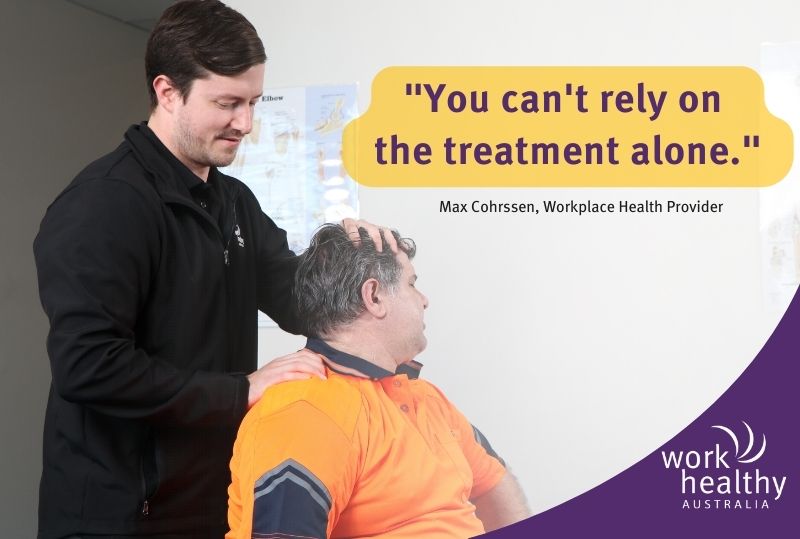
Why do some injured workers readily commit to their rehabilitation treatment and others struggle to follow the recommended exercises in their care plan?
We spoke to some of our Workplace Health Providers to shed light on patient motivation and recovery. They approached three interconnected areas: the worker’s perspective, the provider and the workplace’s support systems.
It might seem straightforward when you have an injured worker, that they attend treatment by a workplace health provider who works their magic, and voila, and after a few sessions, they are feeling better. But the reality is that, when it comes to musculoskeletal health and injury management, you can’t always rely on the treatment alone.
“If a patient is not motivated to change or get better, they won’t”, says Max Cohrssen, Workplace Health Provider at Work Healthy Australia.
“We need a combination of passive treatment from the healthcare provider, and active treatment from the patient, who needs to believe in their recovery and engage in their prescribed exercises and treatment plan.”

So what’s the difference between motivated and unmotivated patients? Work Healthy Australia’s National Operations Manager, Darragh McGovern says that there is a stark difference in a patient who is engaged and actively involved in their care plan, compared to one who is passive and looking for solely external support.
“Those who participate and are involved almost always recover quicker, and remain healthy for longer, if not for good for that particular complaint. Those who don’t can often lead to long care plans, aggravations, and require lifelong ongoing treatment.”
Darragh says it can be very frustrating to work with unengaged patients, “especially when you know as their provider that, if they did become involved in their care plan, they would recover and be better off in the long run.”
There is a stark difference in a patient who is engaged and actively involved in their care plan compared to one who is passive and looking for solely external support.
Darragh McGovern
Barriers to motivated patients
Some barriers to patient motivation in their recovery can be grouped as personal and workplace barriers.
Personal barriers:
- Language and communication: not fully understanding the purpose of their rehabilitation plan, or what they should be doing.
- Social barriers: being socially isolated, having low level of support from friends and family, lacking appropriate space, equipment and/or time to exercise at home.
- Psychological barriers: experiencing high stress, depression, anxiety or other mental health conditions.
Workplace barriers:
- Lack of access for rehabilitation and exercise at work.
- Lack of support, including from immediate supervisors and managers.
- Workplace conflict, relationship between worker and supervisor/peers, organisational pressures.
How can we help others with motivation?
Darragh: “I try to find out what might be the motivator for the person, is it their family, their children, or, if they are ready, can they find motivation internally to do what’s needed?
I try to understand what their challenges are and why they have been unsuccessful in the past. Sometimes it’s not a matter of forcing someone to participate in their care, but helping them to shift some long-standing mindset barriers which may be present. “
Max: “For some people it might be their ability to work and not going on light duties. It could be a family – being able to play with young kids. Are they motivated enough to change? If not, it will probably prolong treatment. A counselling technique that is useful for engaging patients is motivational interviewing. I try to explain to patients that they take an active part in them getting better. Recovery is a journey. Treatment works better when the patient is authentic, the provider is authentic, engaged and empathetic. When you build a relationship with the patient, spending time understanding their life, they will feel more engaged.”
How can workplaces help injured workers feel motivated and engaged in their recovery?
- Provide access: having a dedicated room in the workplace where the injured worker can undertake their rehabilitation plan
- Provide a supportive environment that encourages health-seeking behaviours e.g. dedicating five minutes before starting work, for workers to perform stretching as a group normalises the importance of health and camaraderie, making it ok for workers to feel they can do it too
- Engage management and supervisors with the health, treatment and recovery of all their workers
- Encourage open communication between workers, supervisors and managers.
Case study
A male knife hand at an abattoir presented to Work Healthy Australia with significant pain in the right outer elbow and forearm with loss of strength and difficulties performing his role. He had been experiencing the pain for two weeks.
Following a medical history check and examination, he was diagnosed with a tendinopathy of the extensor muscles of the forearm where they attach at the elbow. In addition to treatment provided on the day, the worker was instructed to strap the elbow while at work, to use ice and anti-inflammatories, and was given stretching and rehabilitative exercises.
Over the following weeks, the worker’s symptoms showed minor improvements, however, they had not progressed as expected. Each session he continued to report that he had not been performing the recommended exercises. While the advice was repeated, this did not change his compliance.
Upon further discussion with the worker, it was determined that he held no value in the rehabilitation exercises, as he did not understand their purpose and how they would help reduce his pain and get him back to his job.
Having the purpose of the exercises explained clearly to him was what motivated him. His symptoms improved significantly a short time after following his rehabilitation program. He continued to progress through his rehabilitation exercises and improved his strength to return to full duties.
Recovery is facilitated by embracing the concept that painful movement can be healthy, which is easier when one has more hope, less worry, and greater social supports and security.
Recovery After Musculoskeletal Injury: Mental and Social Health
Sign up to our monthly enewsletter
"*" indicates required fields
